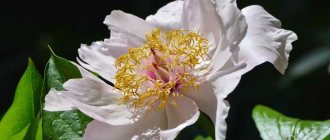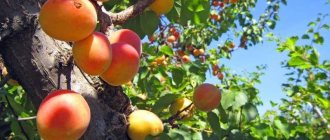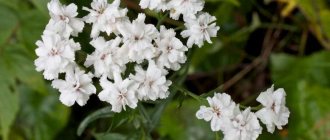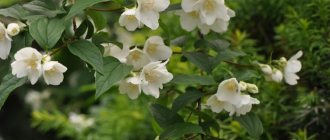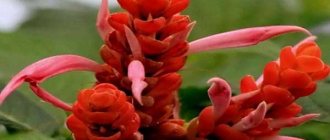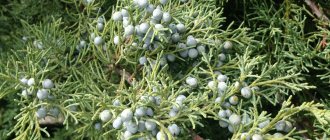8452
Tree peonies are perennial shrubs reaching 1.5 in height. They are distinguished by their rigid, erect shoots, abundant flowering during the growing season, frost resistance and ease of care. Their crown is lush and decorated with lush green leaves. The tree peony varieties in the photo are so diverse that it will not be possible to review them all at once, since there are over a thousand of them.
Favorite of country flower beds
Shrubs differ in the shape of their buds, flower color, structure of the root system, and hardiness. Gardeners prefer to select specimens taking into account the climatic characteristics of a particular region.
Characteristics of types of tree peonies
There are 4 known types of these plants:
Tree peony in the photo
Tree peony (Paeonia suffruticosa), which gave its name to the whole group
Three types of semi-shrub peonies:

Yellow peony (P. lutea)
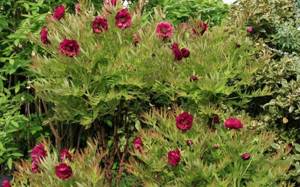
Delavay's peony (P. delavayi)
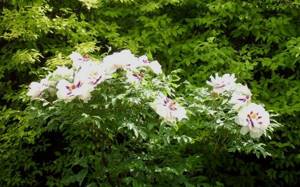
Potanin Peony (P. potaninii)
These photos show the types of tree peonies:

Tree peony, or subshrub in the photo

P. suffructicosa, aka P. montan and P. arborea in the photo
Tree peony , or subshrub (P. suffructicosa, also known as P. montan and P. arborea, is a polymorphic species, which includes all garden forms of tree peonies.
These are exceptionally beautiful shrubs, 1.5 to 2 m high, with large, bright green, double-pinnate leaves. The buds are pale pink. The flowers are white, soft pink or intense pink with a dark magenta spot at the base. The diameter of the flower is 16-20 cm. The stamens with bright yellow anthers are clearly visible. The fruit is a leaflet in non-double carpels, as a rule, 5 carpels, in double ones - from 6 to 10. Each carpel has 6-14 large black shiny seeds.
See what semi-shrub tree-like peonies look like in these photos:

A velvety magenta spot at the base of each petal and numerous large bright yellow stamens make the flower even more striking. From 50 to 100 flowers can bloom simultaneously on one bush. Flowers are single, semi-double, double. The flowering time of one bush is 12-14 days. In the middle zone, tree peonies bloom at the end of May, usually on the 23rd-24th (the timing depends on weather conditions: if spring is early, peonies can begin to bloom on May 17; the latest flowering was observed on June 3). Non-double varieties bloom first, double varieties - three to four days later. After one or two weeks, yellow-flowered semi-shrub peonies begin to bloom.
In semi-shrub species - yellow, Delaway and Potanin peonies - the shoots are straight, few-branched, reach a height of 2 m. The leaves are large, double-triple, up to 55 cm in length with a petiole length of 20 cm.
When describing tree peonies, it is worth noting that in the conditions of the middle zone, these plants very often behave like herbaceous ones: in winter, the entire above-ground part dies off, and grows back by the end of the season. Unlike the tree peony, which has only one flower per shoot, the yellow and Delaway peonies most often have 3-4 flowers.
Flowers are 4-9 cm in diameter. The yellow peony has bright yellow petals, while the Delaway peony has chestnut or dark chestnut petals. The fruit of P. yellow and P. Delaway is a bare, leathery leaf with 3-5 carpels. Freshly collected seeds are large, dark brown, smooth. Both species bloom two weeks later than the tree peony, which makes it possible to prolong the flowering of peonies in your garden. First, non-double varieties bloom, then double ones. They usually bloom for about two weeks.
In all tree peonies, the first circle of stamens around the pistil is sterile. These stamens grow together and form the so-called staminodial disc, which tightly covers the pistils at the bud stage.
As a result of interspecific and intraspecific hybridization, numerous varieties of peonies have been obtained, which are divided into several groups: Chinese-European - with double flowers, Japanese - with single and semi-double flowers, and a yellow peony hybrid.
As can be seen in the photo, the flowers of tree peonies of the Chinese-European group (most varieties were imported to Europe from China) have very large, double, dense petals, and under their weight the branches droop greatly, which reduces the decorativeness of the bush during the flowering period:

In Japan, unlike China, peonies with single or semi-double flowers are grown. The main characteristics of tree peonies of Japanese varieties are light, smaller flowers that rise above the leaves, and the presence of strong peduncles. The range of flower colors is wider. The third group is hybrids of yellow peony, Delaway and Potanin with different forms of P. suffruticosa. Currently, these hybrids are the most popular. Breeders have obtained a very rich range of colors for hybrids - from pure yellow to chestnut with various strokes, giving the flowers the greatest attractiveness.
Below you can see photos and descriptions of the varieties of tree peonies, the most popular in Russian gardens.
Ito-peonies hybrids: varieties with photos and names
A separate group is represented by ito-hybrids - crossed herbaceous and tree-like peonies. The stems of these flowers die off during the winter (like herbaceous ones), and the leaves are like those of tree-like flowers.
Their popularity is growing every year, since they are more winter-hardy than tree-like specimens.
They can be called Japanese peonies, since Toichi Ito was the first in the world to obtain a sample of such a flower and made a kind of revolution.
"Bartzella (Bartzella)" (Bartzella)
The most popular variety, tested by time and thousands of flower growers in the CIS. Height 70-90 cm. Light yellow double and semi-double flowers, spherical in shape. (15-20 cm). The average-late flowering period is 2-3 weeks.

"Bartzella (Bartzella)" (Bartzella)
"Julia Rose "
Height 75-85 cm. The flower is single or semi-double, light pink in color with a very faint aroma and golden stamens. The color changes when the bud opens. Average flowering period, abundant.
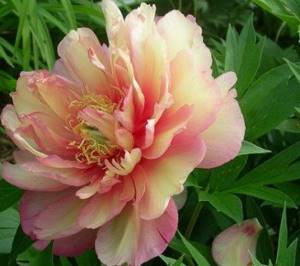
"Julia Rose"
"Pink Hawaiian coral "
Height 75-85 cm. The flower is soft pink (15-20 cm), a large number on the bush.
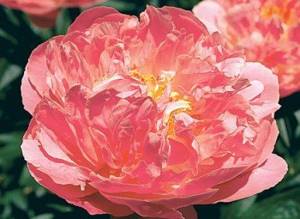
"Pink Hawaiian coral"
"Cora Louise "
Height 80-90 cm. The flower is semi-double or double flower, creamy milky with a purple center (22*24 cm). Subtle and light aroma. Average flowering time.

"Cora Louise"
"Yellow Crown"
Height 50-60 cm. Double or semi-double yellow flower (14-17 cm) with a delicate aroma. Medium-late abundant flowering.

"Yellow Crown"
What tree peonies of yellow varieties look like (with photo)

Peony 'Academician Sadovnichy' in the photo

'Akademik Sadovnichy' . Height 70-100 cm, the flower is located at the level of the upper leaves. The flower is semi-double, cup-shaped, the petals are bright yellow, with a dark purple spot at the base. The stamen filaments of this variety of yellow tree peony are red-purple, the stigma is cream-colored, and the staminodial disc is well defined. One of the best domestic varieties.
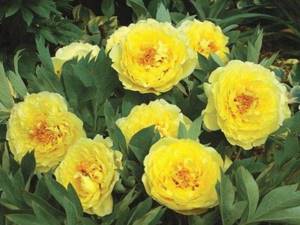
Peony 'Kuindzhi' in the photo

Single flowers, wide petals
'Kuindzhi' . Hybrid variety. The flowers are single, the petals are wide, bright yellow, with a red spot at the base. The filaments are yellow, the staminodial disc is red, and the stigma is yellow.
Pay attention to the photo - this variety of tree peony has flowers on a strong peduncle above the leaves:

'Souvenir de Maxime Cornu' in the photo
'Souvenir de Maxime Cornu' - 'Souvenir de Maxime Cornu' . The flowers are densely double, the petals are bright yellow with a pinkish-cream border around the edge. The flowers are very heavy, the pedicels droop. Bush about 1 m tall. They have a pleasant aroma. They keep well when cut.
The following are photos and descriptions of varieties of red tree peonies.
The best varieties of red tree peonies for the Moscow region
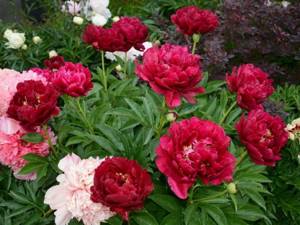
'Vesuvian' pictured
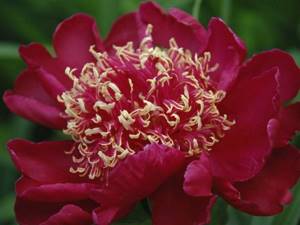
'Vesuvius in the photo
'Vesuvian' - 'Vesuvius'. The flowers are large, double. Petals are crimson-red, numerous. Flowers with pale yellow anthers and short red filaments. The pistils are pale green, with purple stigmas. Bush up to 75 cm tall.

'Vladimir Novikov' in the photo

The flower is semi-double, 18-20 cm in diameter
'Vladimir Novikov' . The petals are red-beet-magenta, with an almost dark purple spot at the base, the edges of the petals are notched and corrugated. The staminodial disc is light with crimson veins, the filaments are crimson with bright yellow anthers. There are 5 or more pistils, the stigmas are pale pink. Bush 130-150 cm high, spreading. This tree peony, suitable for the Moscow region, has dark green leaves.

'Gauguin' pictured

'Gauguin' in the photo
'Gauguin' - 'Gauguin' . The flowers are large, crimson-red. Petals with dark crimson veins, along the edges with a magenta tint. The staminodial disc is dark pink. The stamens are large, with dark red stamen filaments. The height of the bush is up to 1.2 m.

'Coral' in the photo

Blooms in spring and again in mid-summer.
'Coral' . Hybrid variety. The flowers are single, the petals are red-purple, with a dark red spot at the base. The filaments are purple, the staminodial disc and stigma are pink. This is one of the best varieties of tree peonies with a height of more than 100 cm.
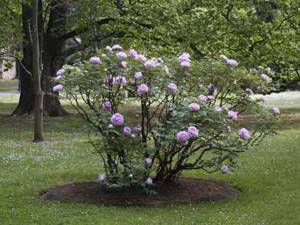
Peony 'Peter the Great' in the photo

The leaves are dark green and large.
'Peter the Great' . The flower is semi-double, 20 -25 cm in diameter, wide open. Petals are lilac-beet color with purple veins. Pistils from 9 to 13, stigmas bright crimson. The staminodial disc is poorly expressed. The filaments are pale lilac in color. Bush 130-150 cm high, spreading, multi-stemmed.

Peony 'Stefan' in the photo
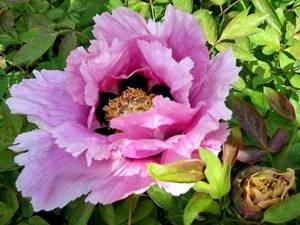
The leaves are bright green.
'Stefan' . The flowers are single, 18-20 cm in diameter. The petals are crimson with lilac veins and a dark purple spot at the base. The staminodial disc is almost invisible. There are five or six carpels, pistils (5-6) with crimson stigmas, the staminate filaments at the base are crimson. Bush 90-100 cm high, small-stemmed, spreading.
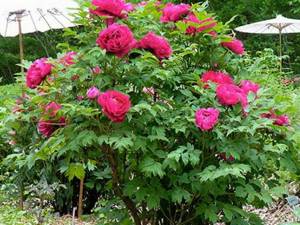
Peony 'Vadim Tikhomirov' in the photo
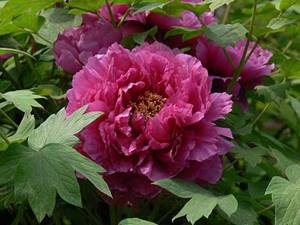
The leaves are dark green.
'Vadim Tikhomirov' . The flower is not double, with a diameter of 11 to 15 cm. The petals are pink, with a small dark crimson spot, with corrugated edges. The staminodial disc is crimson. The filaments are crimson with bright yellow anthers. Pistils with crimson stigmas. Bush 1.5 m high, multi-stemmed. The leaves are dark green.
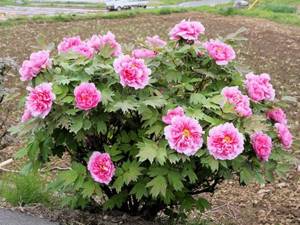
Peony 'Hoffmann' in the photo

The flower is semi-double, 16-18 cm in diameter.
'Hoffmann' . The petals are soft pink, with a pale pink spot. The staminodial disc is white at the base and pale crimson at the top. Pistils with light pink stigmas, light stamen filaments. Bush up to 1.5 m high, multi-stemmed. The leaves are bright green.

Peony 'Irina' in the photo

The leaves are green, without anthocyanin coloring.
'Irina' . The flower is semi-double, the lower petals are large, smaller in the center, forming an inner circle with a diameter of 17 cm. The petals are dark salmon with a dark magenta spot at the base. Staminodial disc violet-red; stigmas of pistils and stamen filaments are bright crimson. Bush up to 170 cm high, multi-stemmed.
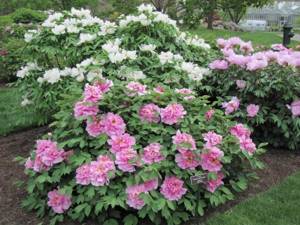
Peony 'Muse' in the photo

The flower is semi-double, 16-17 cm in diameter.
'Muse' . The petals are raspberry pink, forming four circles; external - large, concave, internal - spherical, smaller. This one of the best varieties of tree peonies for the Moscow region has practically no spots on the petals. The staminodial disc is crimson, there are five pistils, the stigmas are pink, the filaments are crimson with bright yellow anthers. Bush 120-130 cm high. Leaves are bright green.
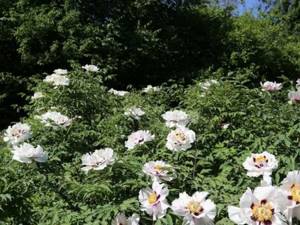
Peony 'Smolin' in the photo

The leaves are bright green.
'Smolin' . The flower is semi-double, multi-row, 22-25 cm in diameter. The petals are pale pink, with a bright purple spot at the base. The staminodial disc is light. The stigmas of the pistils are pink-yellow, the stamen filaments at the base are crimson. The bush is 120-130 cm high, spreading, some shoots lie down. The leaves are green with a brown tint.
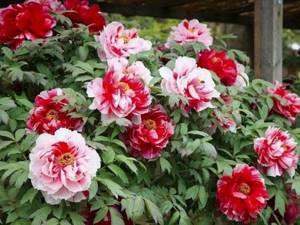
Peony 'Marianna' in the photo

The flower is semi-double, about 18 cm in diameter
'Marianna' . The petals are arranged in three rows, pale salmon, with a dark crimson spot, the edges of the petals are corrugated. The stamen filaments are crimson, the stigmas of the pistils are pale pink. The staminodial disc is beet-colored. The bush is compact, 120-140 cm high. The leaves are bright green.
Below are photos and descriptions of white peony varieties.
Purple, violet, lilac varieties of tree peonies
Flower growers are often faced with an offer to purchase peonies of purple, blue or light blue color. In order not to be disappointed after such a purchase, it is important to know that peony petals cannot be painted in the tones of heavenly blue.
Only when fully bloomed do light lilac, violet, and bluish shades appear on the flowers.
Peony Deep Blue Sea
An example is the tree peony known to Russian flower growers, the Deep Blue Sea with an average flowering period. Shrubs with carved foliage can bear up to 50 large semi-double flowers with a yellow center and purple-red petals. When flowering, which lasts up to two weeks, ends, the plants do not lose their decorative properties. Green, repeatedly dissected leaves remain fresh until frost.
Anyone who is partial to flowers of a deep purple hue will be interested in the description of the Imperial Crown variety of tree peony.
Peony Guan Qun Fang (Imperial Crown)
In its native China and around the world, the plant with dark purple flowers resembling a tall crown is known as Guan Qun Fang. Spectacular, brocade-like corollas are clearly visible against the background of bright green foliage. Flowering occurs in the first half of summer and lasts from 10 to 14 days. If the Imperial Crown tree peony plant is provided with winter shelter and proper summer care, the peony blooms profusely and regularly, and the flowers do not fade for a long time and are excellent for cutting.
Rock Peony (Paeonia rockii) Ocean Purple
Classic Chinese varieties of peonies have not lost their attractiveness today. At the beginning of the last century, unpretentious, but at the same time absolutely luxurious shrubs of the Purple Ocean tree peony appeared in European gardens. The variety, belonging to the Paeonia rockii variety, is also popular in Russia. This is a welcome gift for every peony fan, but not everyone manages to find a seedling.
The Purple Ocean peony variety stands out for its large flowers with a diameter of up to 16 and a height of up to 13 cm. Petals of dark purple tones are decorated with thin white or pink strokes running from the base of the corolla to the edges.
The flowering of peony, called Zi Hai Yin Bo in China, begins in the last days of May and ends by mid-June.
Interestingly, young Imperial Crown peony plants often have lotus-shaped flowers. As the bush matures, it becomes covered with dense terry corollas.
The flowers give off a sweet aroma with notes of fruit and spice. This makes the variety one of the most fragrant. Shrubs of purple tree peony, up to one and a half meters high, are very hardy. With minimal shelter they winter in central Russia.
Winter-hardy varieties of white tree peonies (with photo)

Peony 'August' in the photo
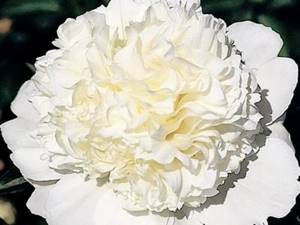
Double flower, 17-18 cm in diameter
'August' . The flower is goblet-shaped and retains its shape until the end of flowering. The petals (13-15 in number) are pure white, with a light pink, almost imperceptible spot at the base. Stamen filaments are white; There are six pistils, the stigmas are light yellow, the staminodial disc is light pink, reaching 1/3 of the height of the pistils. The height of the bush of this winter-hardy variety of tree peonies is 120-130 cm. The leaves are large, bright green.
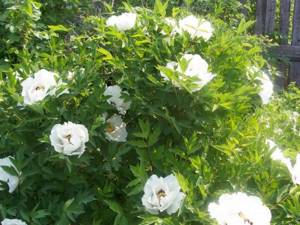
Peony 'Anastasia Sosnowets' in the photo
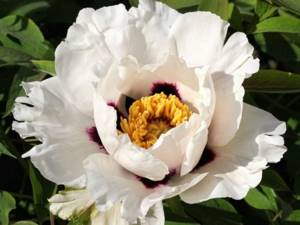
The flower is non-double, compact, 10-11 cm in diameter
'Anastasia Sosnowets' . The flower is not double, the petals are double-rowed, slightly corrugated along the edges, white, with a bright magenta spot at the base. The filaments are white, closer to the anthers with a crimson tint. There are five pistils, the stigmas are light yellow; The staminodial disc is light. Bush up to 1.5 m tall, compact. The leaves are medium-sized, dark green in color.

Peony 'Spring Waltz' in the photo

The flower is not double, 12-14 cm in diameter.
'Spring Waltz' . The petals are pure white, with an almost black spot at the base, the filaments are white, the staminodial disc is red-purple. Bush height - up to 120 cm.
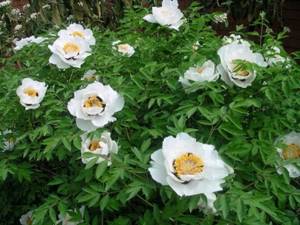
Peony Single flower, 12-14 cm in diameter in the photo
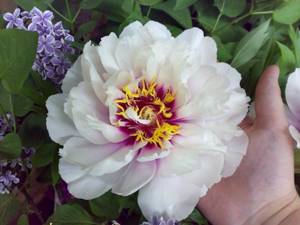
The flower is single, compact, 12-13 cm in diameter
'Vorobievsky' . The flower is single, goblet-shaped, and retains its shape until the end of flowering.
As you can see in the photo, this winter-hardy variety of tree peonies has almost pure white petals, only at the base there are thin magenta lines:

The staminodial disc is white. The filaments are light lilac below, white above; There are five pistils, the stigmas are light yellow. Bush up to 1.5 m high. Green leaves.

Peony 'Maria' in the photo

The flower is semi-double, 18-19 cm in diameter,
'Maria' . The flower is semi-double, the petals are double-rowed, pure white, slightly wavy along the edge. Stamen filaments are light. There are five pistils, the stigmas are light, the staminodial disc is white, slightly colored at the apex. Bush 120-130 cm high, spreading. The leaves are light green, with an anthocyanin border.
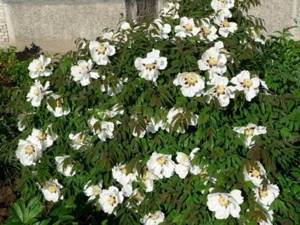
Peony 'Tatiana' in the photo

Semi-double flower, 19-20 cm in diameter
'Tatiana' . The flower is semi-double and retains its shape until the end of flowering. Petals are 2-3 rows, white, with a small crimson spot at the base. The staminodial disc is white, the filaments are crimson; 5-6 pistils, stigmas light yellow. Bush 100-120 cm tall, spreading, multi-stemmed. The leaves are small, lacy, green, with anthocyanin coloring.
Here you can see photos of tree peonies, the description of which is presented on this page:

Tree peony 'Irina' in the photo

Tree peony 'Stefan' in the photo
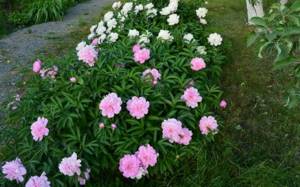
Tree peony 'Hoffmann' photo
Varieties of white tree peonies
White color has traditionally been considered a symbol of purity, freshness and solemnity. It is not surprising that seeing snow-white peonies bloom in your garden is the cherished desire of every fan of these plants. However, due to the natural characteristics of the crop, it is almost impossible to achieve absolute whiteness of the corollas.
The core of white peonies with a crown of stamens has a golden yellow color, and pink or purple-raspberry strokes remain at the base of the petals.
Tree Peony Xue Ta (Snow Tower)
And yet, white tree peonies exist. An excellent example is the popular Chinese variety Xue Ta, Snow Tower or Snow Pagoda. This is a perennial shrub that blooms for the first time at 5–7 years of age and reaches a height of 150 cm by the age of 10 years.
A plant with a medium flowering period is easily recognized by its double flowers, reminiscent of garden roses or anemones. The white-edged petals at the base have a noticeable pinkish or peach tint. Thanks to the fairly rigid stems, even fully opened corollas with a diameter of up to 16 cm do not droop and decorate the lush green bush for several days.
Tree Peony White Jade
Another variety that has long attracted the attention of flower growers is the tree-like peony White Jade, shown in the photo, with snow-white semi-double flowers and a golden crown of their numerous stamens.
The ancient variety, called Yu Ban Bai in China, is considered one of the whitest. However, he won love not only with the unique shade of flowers. The flowers, reminiscent of lotuses, reach 17 cm in diameter. They are clearly visible against the background of dark green carved foliage. Thanks to their rigid flower stalks, peonies look great in a bouquet. Their light sweetish aroma unobtrusively creates a mood of spring and joy.
Tree peony variety White Phoenix
The best varieties of tree peonies include White Phoenix or Feng Dan Bai. The plant with white or slightly pinkish flowers of a simple shape is characterized by a high growth rate and rapid maturation. Large corollas with silky petals open above the foliage before the buds appear on other peony varieties. Therefore, the variety is valued not only for its decorative qualities, but also as an excellent rootstock for other varieties.
Tree peony Scent of Lily
At first acquaintance, the previous variety can easily be confused with the tree peony Smell of a lily, the characteristics of the variety and the appearance of which are very similar.
A tall, large plant with white fragrant flowers will decorate any landscape. Decorative cores in golden and crimson tones give semi-double corollas a special charm and volume.
Tree peonies in garden landscape design (with photo)
Tree peonies in landscape design are one of the most promising crops for landscaping, since with the right agricultural practices they can grow in one place for 50 years or more. Peonies can be recommended both for personal plots and for landscaping squares and parks. Among perennial plants there are few that could compete with them in longevity and unpretentiousness. The buds of tree peonies resemble a rose, and during the flowering period the plants fill the garden with an unusual aroma and delight us with the beauty and variety of flower colors. Peonies can be used to create rock gardens, large landscapes, and to decorate parks and garden plots. They can be planted either in groups or individually on the ground. Peonies look impressive against the background of conifers (for example, silver spruce) or next to architectural structures.
Look how beautiful the tree peonies are in the garden in these photos:
These crops bloom at the same time as lilacs and chestnuts - it is no coincidence that many gardeners plant them nearby.
Scilla, tulips, daffodils, and crocuses can be planted between peony bushes. When these early spring plants fade, the leaves of the regrown peonies will completely cover them.
In large parks, peonies are used to create colorful spots, but it is not advisable to plant them in a continuous strip on the lawn. When creating a landscape composition, you need to think in advance about the combination of peonies in color, size and general appearance, not only during flowering, but also in the summer-autumn period. Ceremonial compositions are created, as a rule, from one type of peonies. In mixed plantings, it is advisable to create separate groups of non-double and double peonies.
Despite the fact that the flowering of individual forms is short-lived, by skillfully selecting tree-like peonies of various varieties in the garden, you can create a composition of continuous flowering. The first, in the 20th of May, will be the non-double varieties of tree peony to bloom, a few days later the double varieties will pick up the baton, and after a couple of weeks the yellow peony will begin to bloom. When tree peonies fade, they will be replaced by early-flowering varieties of herbaceous peonies. As a result, peonies will decorate your garden from mid-May to the end of June.
These photos show tree peonies in the landscape design of city parks and private gardens:
- Author: admin
Rate this article:
- 5
- 4
- 3
- 2
- 1
(26 votes, average: 4.4 out of 5)
Share with your friends!
